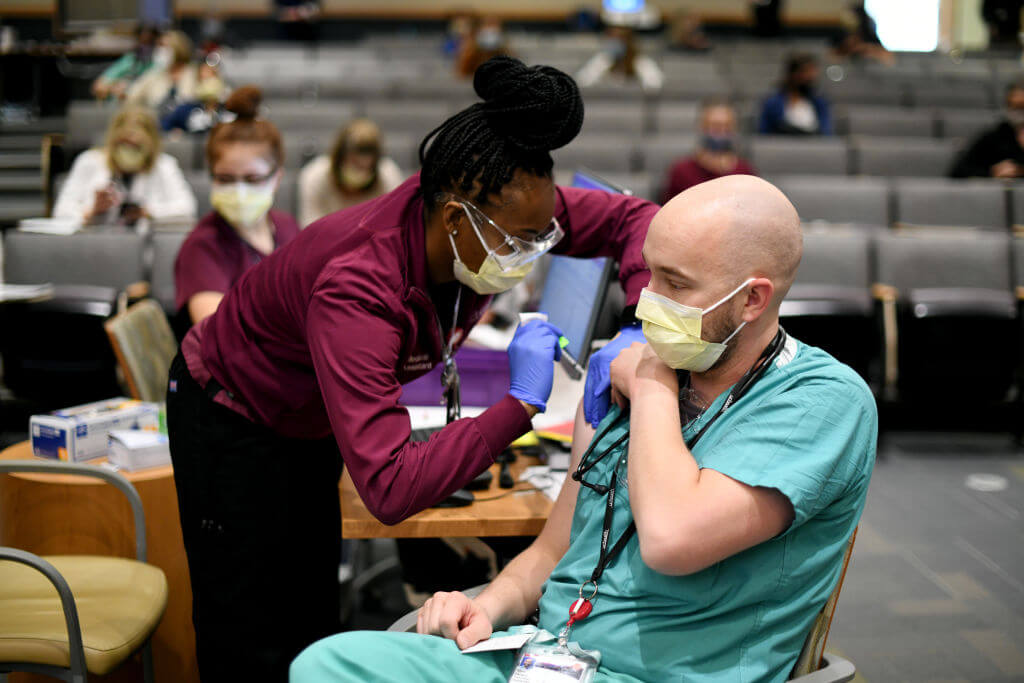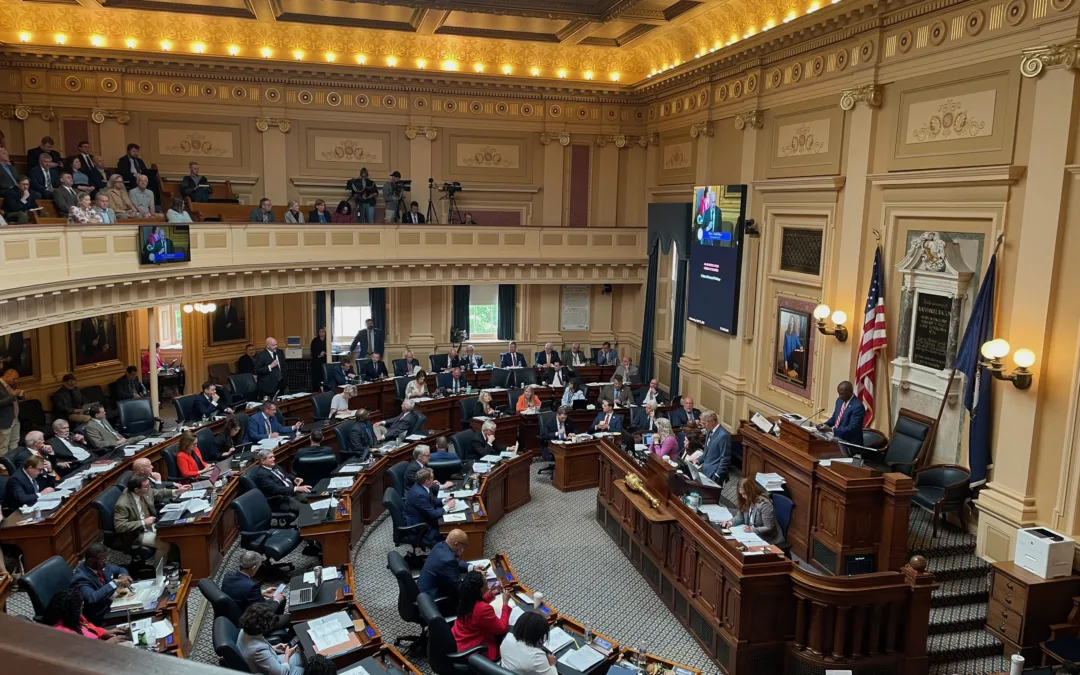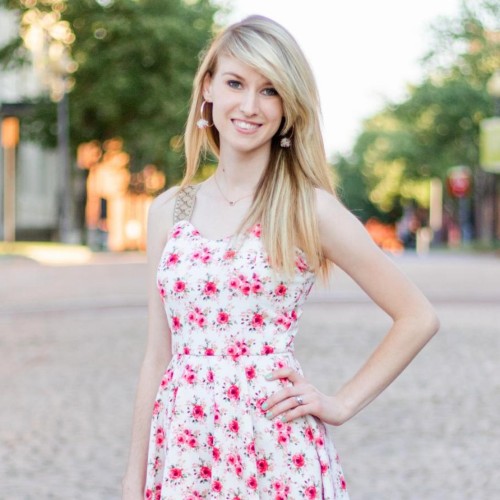
Medical assistant Shalice Wheeler, left, administers Covid-19 vaccine to physician assistant Matt Ferraro. (Photo by Hyoung Chang/MediaNews Group via Getty Images)
Fairfax County officials try different options to reach local communities.
FAIRFAX – What happens when the vaccine to stop a global pandemic comes knocking at your door? Well, Fairfax County took a unique approach.
Months ago, local government leaders and the local health department sat down together to discuss the best action plan. Together, they decided to temporarily close four out of five health clinics, converting them into vaccination centers.
Equipped with an appointment, folks went to their designated center or the main government building vaccination site.
Utilizing that method, Fairfax had large enough spaces to maintain social distancing protocols. They also had staff from the four clinics available to help with the vaccinations.
In the first two and a half months – when vaccines were scarce – the Fairfax Health District vaccinated approximately 200,000 residents.
On April 8, Fairfax Board of Supervisors chairman Jeffrey McKay and other local leaders discussed providing equitable vaccine distribution to underserved communities.
The Virginia Latino Advisory Board, Black Women United for Action, Network NOVA, Rowan Tree and local community members joined the discussion on how to improve healthcare equity.
Fairfax Creates an Equitable Distribution
“Equity is really the driving reason why I got involved in politics in the first place,” McKay said. “Growing up in the Route 1 Corridor, seeing some inequities in Fairfax County, has been the work of my political life and certainly is a guiding force in how we are responding to this pandemic.”
The chairman noted that he did not only hope to make equitable improvements while the pandemic raged on. He strove to make long-term impacts, creating a more resilient and equitable county as a whole.
“COVID-19, we all pray, will come and go. It’s certainly endured longer than I think any of us could have predicted. But we know it will come and go. The real question is when it does go, how successful were we?” McKay said. “And more importantly, did we take advantage of this moment in time to erase or eradicate many of the inequities that we have seen a spotlight shine on over the last year, year plus?”
McKay referred to the situation as an opportunity to learn and then pivot toward becoming better.
Reaching the Community
Black Women United for Action representative Barika Porter inquired about community efforts to get the word out about the vaccine.
“We’ve known from the beginning that many vaccines and dealing with some of the hesitancy issues are much better handled by our community partners than government themselves. And so we’ve been trying to get as many vaccines in hand as we can and get those vaccines out to our community partners to be able to administer those,” McKay said. “But most importantly we’re working with a lot of those groups to help get people registered for the vaccine in the first place.”
One of the challenges that the area saw arose from the multi-dose requirements for both Pfizer and Moderna vaccines. That involved not only getting people to come for the first dose. It also involved getting them to come back for the second.
The issue quickly became an even larger challenge. The county gets a week-by-week update on how many doses they will actually receive. Due to the fluctuating numbers, community leaders offer only what they can guarantee.
“And so when we’re looking to move forward with door-to-door operations, mobile clinics, like we did with testing in our communities, those things are also largely contingent upon getting enough vaccine to be able to get out there in the community,” McKay said. “So it’s a two-part challenge: getting people registered [and] getting the vaccine out into the community.”
Karla Bruce, Fairfax County’s chief equity officer, also spoke on the issue.
“We’ve been really restricted on some of our efforts, not from the desire and intent to want to do it, but by the limits of the vaccine coming into our community,” Bruce said.
Understanding Inequity
Fairfax County leaders did not address the issue blindly. They spoke with community leaders – like houses of worship – to see the bigger picture.
“Our community relationships have been essential to [understanding] what the inequity is, who is not being served and why aren’t they being served,” Bruce said. “So part of it is an awareness issue. And where it’s awareness, it’s about, you know, getting information into the hands of people through people that they trust.”
The county currently has a roster of over 400 organizations. The list represents nonprofits, faith-based community leaders and civic organizations. They help pass information throughout the community.
Vaccine Difficulty
Paul Berry, chairman of the Virginia Latino Advisory Board, addressed vaccine difficulty. People with second jobs, a lack of transportation, health information gaps and language barriers could experience issues getting the shot.
McKay acknowledged that transportation was a major issue for some individuals.
“Getting to a main vaccination center at the government center is an all day affair for some people,” Mckay said. “And it’s inequitable by unfortunate design, even though it’s a convenient mass vaccination clinic.”
In response, the county opened up a vaccination center on Eisenhower Ave to serve South County, and also relied on partnerships with local pharmacies.
McKay also noted the need to get the message out about vaccines to underserved communities before taking the vaccines there.
“We also have to move the message closer to people so we can get the vaccine closer to people. We have to move the message closer. And that’s where multiple languages, the work every week of the health department with our community partners getting the word out is so absolutely vital because we know you can help us with that more than we can do it ourselves,” McKay said. “If we’ve learned anything through the last year through our County Trust Policy and many of the other programs we’ve put in place, government is not always the best deliverer of information to certain communities. And there still is a tremendous, reasonable amount of distrust out there.”
Fairfax Launches Equity Clinics
Dr. Ben Schwartz, head of epidemiology and population health at the Fairfax County Health Department, said that next week, the county will host vaccines in apartment complexes. Some of those locations, he noted, experienced a disproportionate spread of disease.
“And these are the same apartment complexes where we had had testing events earlier in the pandemic,” Schwartz said. “So using the connections that we’ve made with the apartment managers, with the community, with the local organizations that serve that community, we are really trying to reach out as much as we can to hold these clinics and to vaccinate people who otherwise would not be able to access the vaccination.”
Language Barriers
Phyllis Simon with Rowan Tree’s anti-racism and equity and action committee inquired about Fairfax’s priorities in relation to language and accessibility barriers as a part of public health goals.
“Fairfax County has access to resources for translating election-related materials into Spanish, Vietnamese and Korean,” Simon said. “In addition, many Fairfax County schools also provide information in other non-English languages such as Arabic [inaudible] and Chinese.”
She questioned whether or not the county tapped into the same resources to translate COVID and COVID vaccine-related information to non-English languages.
The county and state actively offer translation options for non-English speakers, which McKay explained in depth.
“I would say that the health department has an outreach team and they have supported the development of robust multi-language materials – written, radio, video messaging – that we’ve been doing in Spanish, Vietnamese, Chinese, Korean, Arabic, Farsi. The county continues to have a multilingual communications message and strategy,” McKay said. “Equally important, we have, seven days a week at our [call centers], we have English and Spanish speaking call-takers working seven days a week. And for other languages, we have accommodated those with a live agent that, you know, is available during certain times for translation services.”
In addition, vaccination sites in the county also have interpreters available for in-person translation services.
Even with the multitude of equity advancements in place, McKay welcomed additional feedback and ideas.
“I will acknowledge, we can always do more,” McKay said.
Amie Knowles reports for Dogwood. You can reach her at [email protected]
Politics

Youngkin, Democrats to start over on budget talks
The Republican governor stood with Democratic leaders in the General Assembly on Wednesday in a bid to ease tensions over their budget debate....

VIDEO: Domestic abuse victims speak out against the gun law bills Gov. Glenn Youngkin vetoed
Senate Bill 47 and House Bill 46 aim to close the loophole that allows offenders to transfer their firearms to someone else instead of relinquishing...
Local News

Virginia verses: Celebrating 5 poetic icons for National Poetry Month
There’s no shortage of great writers when it comes to our commonwealth. From the haunting verses of Edgar Allan Poe, who found solace in Richmond's...

Join the fun: Recapping Family Literacy Night’s storybook adventures
When’s the last time you read a book aloud with a loved one? If it’s difficult to answer that question, then maybe it’s time to dust off that TBR...





